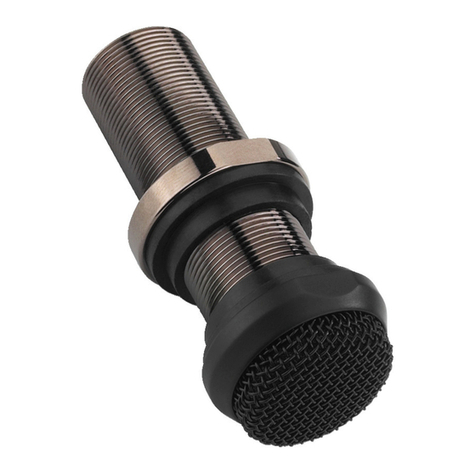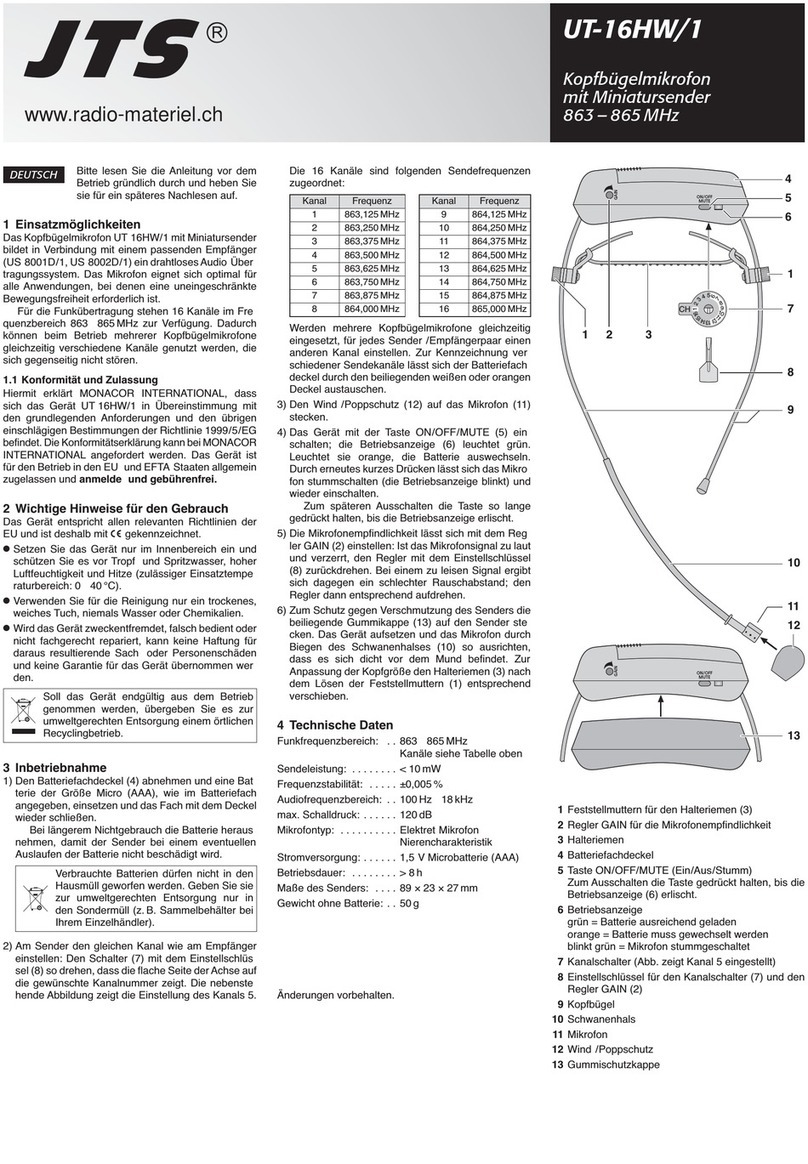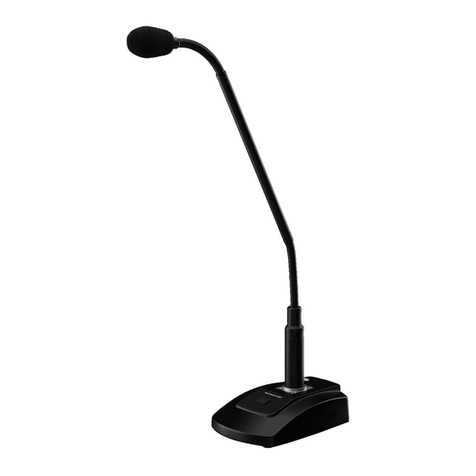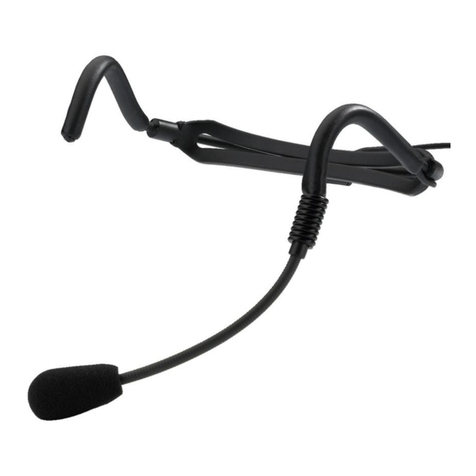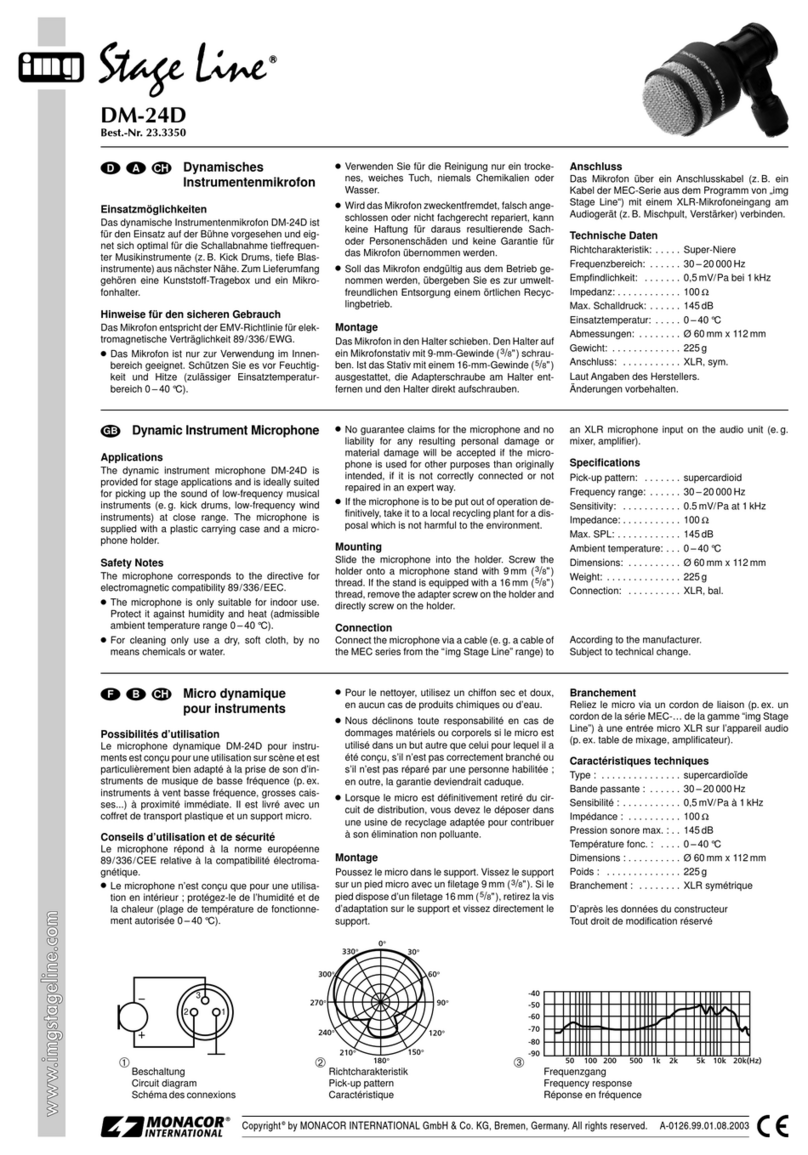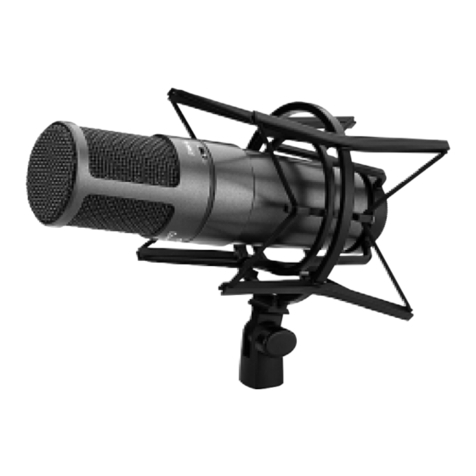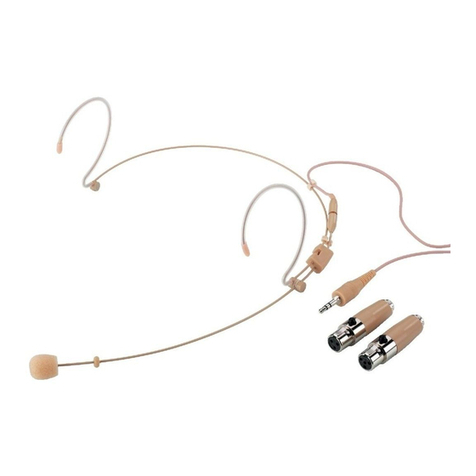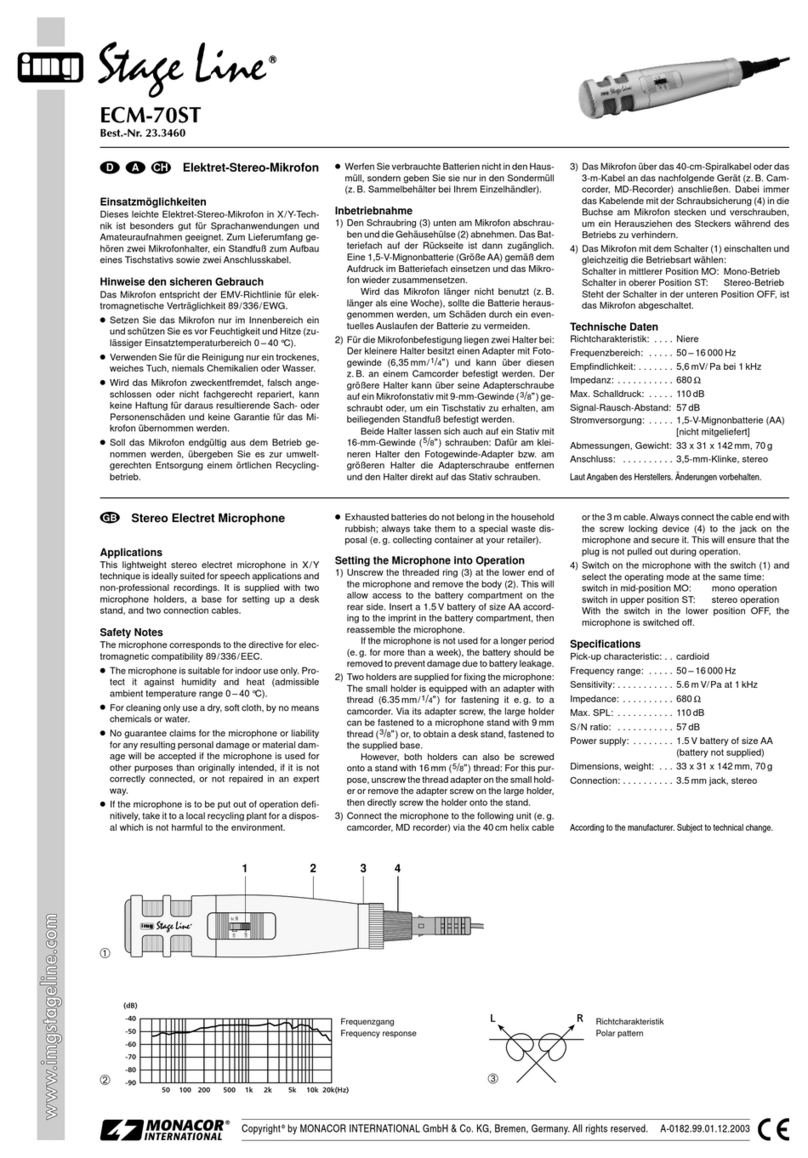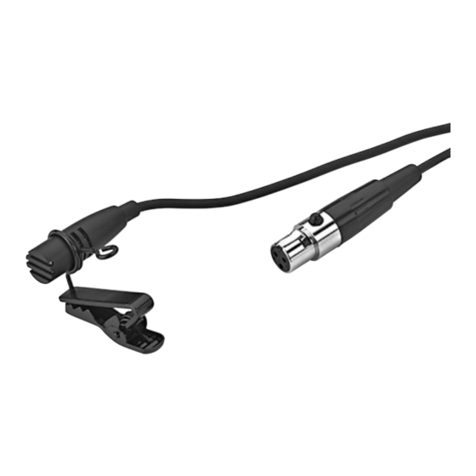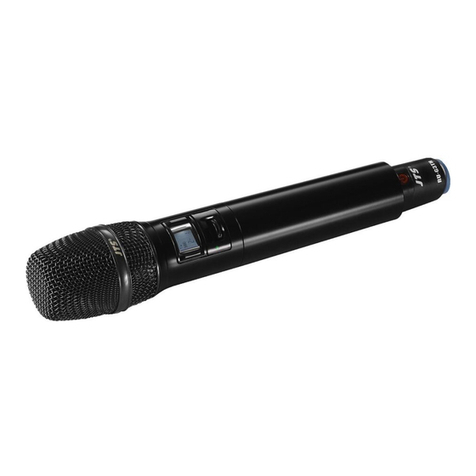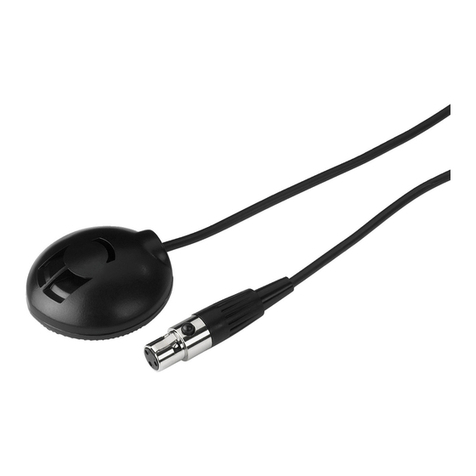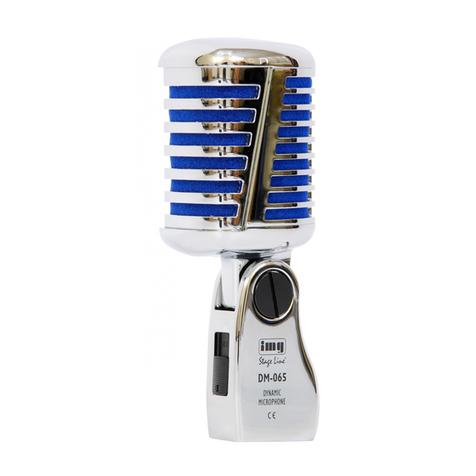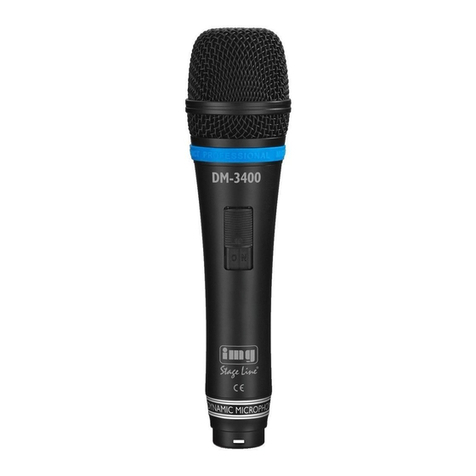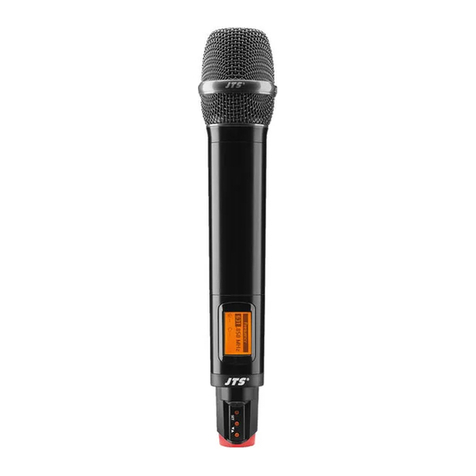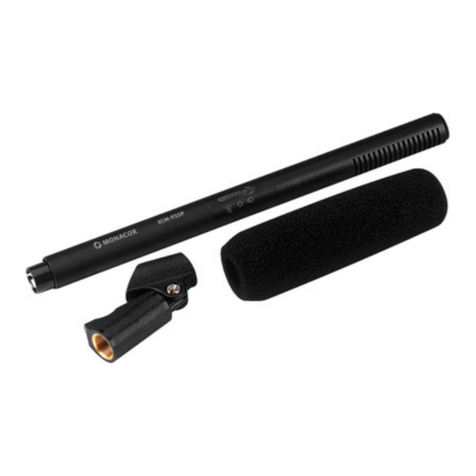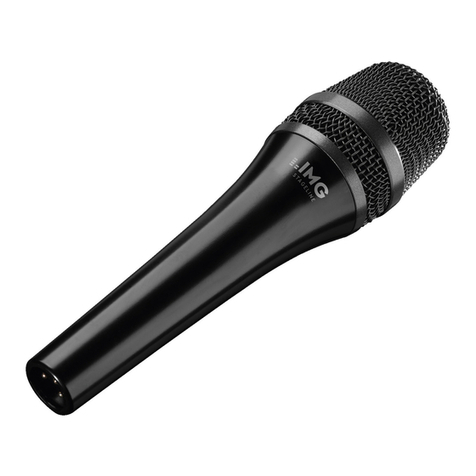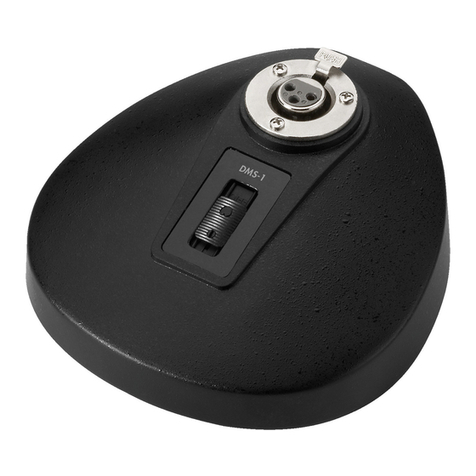
ELECTRONICS FOR SPECIALISTS ELECTRONICS FOR SPECIALISTS ELECTRONICS FOR SPECIALISTS ELECTRONICS FOR SPECIALISTS ELECTRONICS FOR SPECIALISTS ELECTRONICS
HSE-300/SK Bestell-Nr. •Order No. 23.4080
HSE-310/SK Bestell-Nr. •Order No. 23.4120
HSE-330/SK Bestell-Nr. •Order No. 23.0140
MONACOR INTERNATIONAL GmbH & Co. KG • Zum Falsch 36 • 28307 Bremen • Germany
Copyright©by MONACOR INTERNATIONAL. All rights reserved. A-0449.99.04.07.2019
Mikrofon nagłowny
Niniejsza instrukcja przeznaczona jest dla użyt-
kowników, którzy nie posiadają wiedzy i do-
świadczenia technicznego. Przed rozpoczęciem
użytkowania proszę zapoznać się z instrukcją, a
następnie zachować ją do wglądu.
1 Zastosowanie
Mikrofon nagłowny HSE-3xx jest mikrofonem woka-
lowym (do zastosowań muzycznych oraz konferen-
cyjnych). Jest idealny do zastosowania tam, gdzie
potrzebna jest duża swoboda ruchu. Do popraw-
nej pracy wymagane jest zasilanie prądem stałym
(1,5–9V). W ofercie MONACOR dostępne są zasilacze
do mikrofonu HSE-310/SK (np. EMA-1, EMA-300P) lub
nadajnik kieszonkowy do bezprzewodowej transmisji
akustycznej (z serii TXS-...HSE).
2 Bezpieczeństwo użytkowania
Urządzenie spełnia wszystkie wymagania norm UE i
dlatego posiada oznaczenie symbolem .
•
Urządzenie jest przeznaczone do użytku tylko w
pomieszczeniach. Urządzenie należy chronić przed
działaniem wody, wysokiej wilgotności powietrza
oraz wysokiej temperatury (dopuszczalna tempera-
tura otoczenia pracy 0–40°C).
•
Do czyszczenia urządzenia należy używać suchej,
miękkiej tkaniny; nie należy stosować wody ani
środków czyszczących.
•
Producent ani dostawca nie ponoszą odpowiedzial-
ności za wynikłe szkody (uszkodzenie sprzętu lub
obrażenia użytkownika), jeśli urządzenie było uży-
wane niezgodnie z przeznaczeniem, niewłaściwie
zainstalowane lub obsługiwane, albo jeśli było pod-
dawane nieautoryzowanym naprawom.
Jeśli urządzenie ma zostać ostatecznie
wycofane z użycia, należy przekazać je do
punktu utylizacji odpadów, aby uniknąć
zanieczyszczenia środowiska.
3 Przygotowanie do pracy
1) Należy
założyć
na
mikrofon
osłonę
przeciwwietrzną/
zabezpieczającą.
2) Należy założyć mikrofon na głowę, umieścić
wkładkę mikrofonową blisko ust w wygodnej po-
zycji. W tym celu można poruszać ramieniem mi-
krofonu we wszystkich kierunkach.
3) Należy podłączyć mikrofon do podłączyć gniazdo
nakablowe typu mini XLR do gniazda nadajnika
kieszonkowego lub zasilacza (zasilacz należy
następnie połączyć z wejściem urządzenia audio).
W razie potrzeby należy podłączyć zasilacz.
4 Dane techniczne
Typ mikrofonu:. . . . . . . . . . . . mikrofon elektretowy
Charakterystyka mikrofonu: . kardioidalna
Pasmo przenoszenia: . . . . . . . 50 – 18000Hz
Impedancja: . . . . . . . . . . . . . . 2 kΩ
Czułość: . . . . . . . . . . . . . . . . . . 2,3 mV/Pa przy 1kHz
Maks. SPL.: . . . . . . . . . . . . . . . 120 dB
Zasilanie:. . . . . . . . . . . . . . . . . ⎓ 1,5– 9 V
Waga (bez kabla): . . . . . . . . . 18 g
Podłączenie:
1
2
3
HSE-310/SK
HSE-300/SK
HSE-330/SK
niebieski = sygnał
sygnał
sygnał
ekranowanie
ekranowanie
ekranowanie
gołe zakończenie kabla
z wtykiem 3,5 mm
1,5
-
9
V (⎓)
1,5
-
9
V (⎓)
z gniazdem nakablowym mini XLR
czerwony = 1,5
-
9
V (⎓
Z zastrzeżeniem możliwości zmian.
Micro diadema
Estas instrucciones van dirigidas a usuarios sin
ningún conocimiento técnico específico. Lea
atentamente estas instrucciones antes de utili-
zar el aparato y guárdelas para usos posteriores.
1 Aplicaciones
El micro de diadema HSE-3xx está especialmente
diseñado para sonido vocal y aplicaciones de habla
que requieren mucha libertad de movimiento. Para
el funcionamiento es necesaria una tensión DC entre
1,5V y 9V. Especialmente para el modelo HSE-310/SK
un adaptador de alimentación (por ejemplo EMA-1,
EMA-300P) o para transmisión inalámbrica un emisor
de petaca (TXS-...HSE) están disponibles dentro de la
gama MONACOR.
2 Notas de seguridad
El micro cumple con todas las directivas relevantes
de la UE por lo tanto está marcado con el símbolo .
•
El micro ha estado diseñado solamente para la utili-
zación en el interior. Protéjalo contra las salpicadu-
ras y las proyecciones de agua, una alta humedad
del aire y del calor (temperatura de ambiente
admisible 0–40°C).
•
Para la limpieza utilice únicamente un trapo seco
y suave, nunca utilice productos químicos o agua.
•
La unidad carecería de todo tipo de garantía en
caso de daños personales o materiales resultantes
de una utilización de la unidad con otro fin del que
le es propio, si no está correctamente conectada o
no ha estado reparada por un experto.
Si el micro está definitivamente retirado de
servicio, llévelo a una planta de reciclaje
próxima para contribuir a su eliminación
no contaminante.
3 Puesta en funcionamiento
1) Coloque la protección anti viento.
2) Póngase el micro de diadema y coloque la cáp-
sula del micro de manera que le quede cerca de la
boca en una posición favorable para hablar. Para
hacerlo, puede mover el brazo del micro en todas
las direcciones.
3) Conecte el micro a la otra unidad, vea esquema. Si
es necesario, utilice un adaptador de alimentación.
4 Especificaciones
Tipo de micro:. . . . . . . . . . . . . back electret
Característica: . . . . . . . . . . . . . cardioide
Índice de frecuencia: . . . . . . . 50 –18000Hz
Impedancia: . . . . . . . . . . . . . . 2 kΩ
Sensitividad: . . . . . . . . . . . . . . 2,3 mV/Pa a 1kHz
Presión sonora máx.: . . . . . . . 120 dB
Fuente de alimentación: . . . . ⎓ 1,5 –9 V
Peso sin cable:. . . . . . . . . . . . . 18 g
Conexión:
1
2
3
HSE-310/SK
HSE-300/SK
HSE-330/SK
rojo = 1,5
-
9
V (⎓)
azul = señal
señal
señal
blindaje
blindaje
blindaje
con cables pelados
con jack XLR mini en línea
con toma de 3,5 mm
1,5
-
9
V (⎓)
1,5
-
9
V (⎓)
Sujeto a modificaciones técnicas.
Microfono headset
Queste istruzioni sono rivolte all’utente senza
conoscenze tecniche specifiche. Vi preghiamo di
leggerle attentamente prima della messa in fun-
zione e di conservarle per un uso futuro.
1 Possibilità d’impiego
Il microfono headset HSE-3xx è adatto in modo otti-
male per applicazioni di canto e di lingua parlata che
richiedono molta libertà di movimento. Per il funzio-
namento è richiesta una tensione continua fra 1,5V
e 9V. A tale scopo sono disponibili, dal programma di
MONACOR, specialmente per il modello HSE-310/SK
un adattatore di alimentazione (p.es. EMA-1, EMA-
300P) oppure, per la trasmissione audio senza fili, un
trasmettitore tascabile (TXS-...HSE).
2 Avvertenze di sicurezza
Il microfono è conforme a tutte le direttive rilevanti
dell’UE e pertanto porta la sigla .
•
Far funzionare il microfono solo all’interno di locali
e proteggerlo dall’acqua gocciolante e dagli spruzzi
d’acqua, da alta umidità dell’aria e dal calore (tem-
peratura d’impiego ammessa fra 0 e 40°C).
•
Per la pulizia usare solo un panno morbido,
asciutto; non impiegare in nessun caso prodotti
chimici o acqua.
•
Nel caso d’uso improprio, di collegamenti sbagliati
o di riparazione non a regola d’arte del microfono,
non si assume nessuna responsabilità per eventuali
danni consequenziali a persone o a cose e non si
assume nessuna garanzia per il microfono.
Se si desidera eliminare il microfono defini-
tivamente, consegnarlo per lo smaltimento
ad un’istituzione locale per il riciclaggio.
3 Messa in funzione
1) Applicare la protezione antivento.
2) Sistemare il microfono headset in testa e portare la
capsula del microfono vicino alla bocca in una posi-
zione adatta per parlare. A tale scopo, il braccio del
microfono può essere piegato in tutte le direzioni.
3) Collegare il microfono con l’apparecchio a valle,
vedi illustrazione. Eventualmente inserire un adat-
tatore di alimentazione.
4 Dati tecnici
Tipo di microfono: . . . . . . . . . back-elettrete
Caratteristica direzionale: . . . cardioide
Gamma di frequenze: . . . . . . 50 –18000Hz
Impedenza:. . . . . . . . . . . . . . . 2kΩ
Sensibilità:. . . . . . . . . . . . . . . . 2,3 mV/Pa con 1kHz
Pressione sonora max.:. . . . . . 120 dB
Alimentazione:. . . . . . . . . . . . ⎓ 1,5– 9 V
Peso senza cavo:. . . . . . . . . . . 18g
Collegamento:
1
2
3
HSE-310/SK
HSE-300/SK
HSE-330/SK
rosso = 1,5
-
9
V (⎓)
segnale
segnale
schermatura
schermatura
schermatura
con terminali del cavo deisolati
con jack 3,5 mm
1,5
-
9
V (⎓)
1,5
-
9
V (⎓)
con presa Mini-XLR
blu = segnale
Con riserva di modifiche tecniche.
ItalianoEspañolPolski
